What Is the Difference Between Cilantro and Culantro?
.png) |
Difference Between Cilantro and Culantro |
Cilantro:
Cilantro is also known as Chinese parsley and is commonly used in Mexican, Caribbean, and Asian cuisine. It has a bright and fresh flavor and is used as a garnish or in dishes such as salsa, guacamole, and salads.
Culantro:
Culantro is a tropical herb that is commonly used in Latin American, Caribbean, and Southeast Asian cooking. It has a strong, pungent flavor and is often used in stews, soups, and sauces. Unlike cilantro, culantro has serrated leaves.
In short, while cilantro and culantro look similar, they are different herbs with distinct flavors and uses.
The difference in taste between Cilantro and Culantro:
Cilantro and culantro have different tastes. Cilantro has a bright, citrusy flavor that is often described as fresh and slightly sweet. It's often used as a garnish or in dishes like salsa, guacamole, and salads.
Culantro has a stronger, more pungent flavor that is often described as earthy and slightly bitter. It's used in dishes such as stews, soups, and sauces, and is commonly found in Latin American, Caribbean, and Southeast Asian cuisine. The flavor of cilantro is often described as being similar to that of cilantro, but with a more intense and robust taste.
The difference in Appearance between Cilantro and Culantro:
Cilantro and culantro have similar-looking leaves, but there are some notable differences in their appearance. Cilantro has delicate, feathery leaves that are typically a bright green color. They are lacy and tender and are typically used as a garnish.
Culantro has broader, more robust leaves that are a darker green color. The leaves of culantro are also more serrated, or jagged, around the edges, while cilantro leaves have smoother edges. Culantro leaves are often used in cooking and are known for their intense flavor.
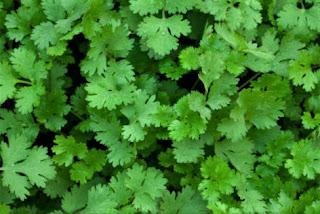 |
Cilantro |
The difference in Culinary Uses between Cilantro and Culantro:
Cilantro and culantro have different culinary uses, despite their similar appearance and flavors. Cilantro is a staple in Mexican, Caribbean, and Asian cuisine and is often used as a garnish or in dishes like salsa, guacamole, and salads. Its bright, fresh flavor makes it a popular ingredient in many different types of cuisine.
Culantro is more commonly used in Latin American, Caribbean, and Southeast Asian cooking. Its strong, pungent flavor makes it well-suited for use in dishes like stews, soups, and sauces. Culantro is also often used to season rice, meat, and fish dishes.
Cilantro and culantro have similar flavors, but they have different culinary uses. Cilantro is used as a garnish or in lighter dishes, while culantro is used in heavier, more flavorful dishes like stews and sauces.
The difference in Harvesting between Culantro and Cilantro:
Cilantro and Culantro can be harvested for their leaves, but there are differences in the best time to harvest and how to harvest the leaves.
Cilantro is typically harvested for its leaves when the plant has reached about 8-10 inches in height. The leaves can be harvested by cutting off the top few inches of the plant, leaving the lower leaves to continue growing. Cilantro leaves can be harvested at any time during the growing season, The flavor is best when the leaves are young and tender.
Culantro can be harvested for its leaves when the plant is about 8-12 inches tall. The leaves can be harvested by cutting off the top few inches of the plant, or by cutting individual leaves as needed. Culantro leaves are more robust than cilantro leaves and can be harvested multiple times during the growing season.
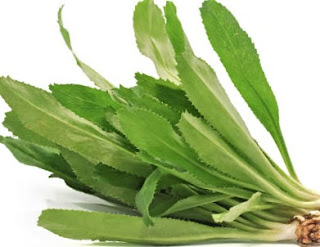 |
Culantro |
The difference in smells between Cilantro and Culantro:
Cilantro has a bright, citrusy, and slightly pungent smell and is described as bright, fresh, and slightly lemony. Cilantro is widely used in many different types of cuisine, including Mexican, Thai, and Indian, and is often used as a garnish or to add a fresh, herbal flavor to dishes.
Culantro has a stronger, more pungent smell and a stronger flavor. It is less widely used than cilantro and is more commonly found in Latin American, Caribbean, and Southeast Asian cuisine. Culantro is often used in dishes like stews, soups, and sauces, and its strong flavor can add depth and complexity to dishes.
Cilantro and culantro have different smells. Cilantro has a bright, citrusy smell and a bright, fresh flavor, while culantro has a stronger, more pungent smell.
The Nutrients difference between Culantro and Cilantro:
Cilantro and culantro are nutrient-dense herbs and contain a variety of vitamins and minerals.
Cilantro is a good source of vitamins A, C, and K, as well as potassium, iron, and calcium. Cilantro has anti-inflammatory properties and is also rich in antioxidants.
Culantro is also a good source of vitamins A, C, and K, as well as potassium, iron, and calcium. Culantro has anti-inflammatory properties and is also rich in antioxidants. Additionally, culantro has been used in traditional medicine to treat various health conditions, including digestive issues and skin conditions.
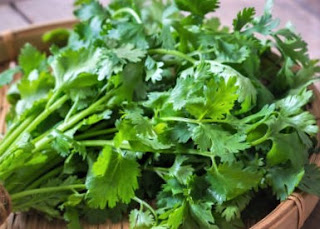 |
Cilantro |
The difference between the availability of Culantro and Cilantro:
Cilantro and culantro have differences in their availability.
Cilantro is widely available in many grocery stores and supermarkets around the world. It's a common ingredient in many different types of cuisine and is often used as a garnish or in dishes like salsa, guacamole, and salads.
Culantro is less widely available and is more commonly found in Latin American, Caribbean, and Southeast Asian grocery stores. It is less well-known than cilantro and is not as commonly used in Western cuisine.
Cilantro is widely available and commonly used in many different types of cuisine, while culantro is less well-known and more commonly found in specialty grocery stores that cater to Latin American, Caribbean, and Southeast Asian cuisine.
Health Benefits of Cilantro and Culantro:
Cilantro and Culantro have been shown to have potential health benefits. Some of these benefits include:
Antioxidant properties:
Cilantro and Culantro contain antioxidants that can help protect the body from damage caused by free radicals.
Anti-inflammatory effects:
Cilantro and culantro have anti-inflammatory properties that can help reduce inflammation and pain in the body.
Improved digestion:
Cilantro and Culantro can help improve digestion and reduce symptoms of digestive issues like bloating and gas.
Better cardiovascular health:
The anti-inflammatory and antioxidant properties of cilantro and culantro can also help improve cardiovascular health and reduce the risk of heart disease.
Reduced risk of cancer:
Cilantro and culantro have properties that can help reduce the risk of certain types of cancer.
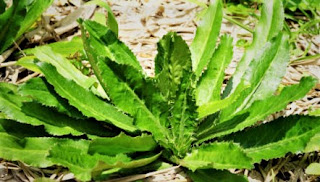 |
Culantro |
Culantro and Cilantro difference of Flowers & Propagation:
Cilantro and culantro produce flowers, although the way they propagate is different.
Cilantro produces delicate white or light pink flowers on top of tall, thin stems. The flowers are often used as a garnish or as a source of nectar for pollinators. Cilantro is an annual herb and typically self-seeds, meaning that new plants will grow from the seeds produced by the previous year's crop.
Culantro produces small, greenish-white flowers that form on short, compact spikes. The flowers are not often used in cooking or as a garnish, and culantro is typically propagated by cuttings or division.
Cilantro and Culantro produce flowers, but the way they propagate is different. Cilantro self-seeds and produces delicate white or light pink flowers, while culantro is typically propagated by cuttings or division and produces small, greenish-white flowers.
Can culantro be substituted for cilantro:
Culantro and cilantro have similar flavor profiles, but they are not identical. Culantro has a stronger, more pungent flavor and a more bitter taste compared to cilantro, which has a bright, citrusy flavor.
While cilantro can be substituted for Culantro in some dishes, it may alter the flavor of the dish, especially if a large amount is used. It's best to use Culantro as a substitute in dishes where a stronger flavor is desired or in dishes that are traditionally made with culantro, such as certain Latin American, Caribbean, and Southeast Asian dishes.
If you are substituting Culantro for cilantro, it is recommended to start with a small amount and adjust to taste, as too much Culantro can overwhelm the dish.
 |
Cilantro |
Where to buy culantro and cilantro?
Cilantro and culantro are both commonly found in grocery stores and supermarkets. Here are some places where you may be able to find them:
Grocery stores:
Look in the produce section for fresh cilantro and culantro. They are typically sold in bunches or as individual stems.
Supermarkets:
Many larger supermarkets carry cilantro and culantro, often in the produce section.
Farmers' markets:
You are able to find fresh cilantro and culantro at local farmers' markets, especially during the growing season.
Ethnic markets:
If you are looking for culantro specifically, try looking in ethnic markets that specialize in Latin American, Caribbean, or Southeast Asian foods.
Online:
You can also purchase cilantro and culantro seeds online to grow your own herbs at home.
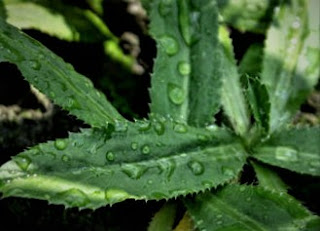 |
Culantro |
How to store cilantro and cilantro?
Storing cilantro and culantro properly can help extend their shelf life and prevent spoilage. Here are some tips for storing these herbs:
Cilantro:
Store cilantro in the refrigerator, either in a plastic bag or wrapped in damp paper towels. You can also place the stems in a glass of water, cover the top with a plastic bag, and store them in the refrigerator. If you want to keep the fresh herbs change the water every few days.
Culantro:
Store the culantro in the same way as cilantro, in the refrigerator either in a plastic bag or wrapped in damp paper towels. You can also place the stems in a glass of water, cover the top with a plastic bag, and store them in the refrigerator. If you want to keep the fresh herbs change the water after a few days like cilantro.
Cilantro and Culantro can last up to a week when stored properly in the refrigerator. To extend their shelf life, avoid storing them near ethylene-producing fruits and vegetables, such as apples and bananas.
In conclusion, store cilantro and culantro in the refrigerator, either in a plastic bag or wrapped in damp paper towels, or place the stems in a glass of water and cover them with a plastic bag. Change the water every few days to keep the herbs fresh, and avoid storing them near ethylene-producing fruits and vegetables.
.png)



.png)
.png)



No comments:
Post a Comment
Please do not enter any spam link in the comment box.